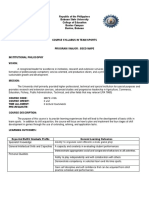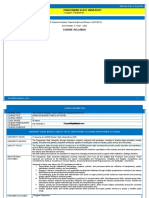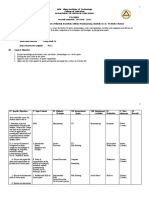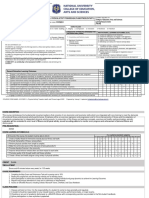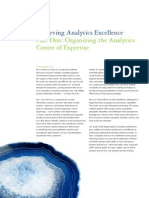Department of Teacher Education: Gpe 1 - Course Syllabus
Department of Teacher Education: Gpe 1 - Course Syllabus
Uploaded by
Jaymar ReponteCopyright:
Available Formats
Department of Teacher Education: Gpe 1 - Course Syllabus
Department of Teacher Education: Gpe 1 - Course Syllabus
Uploaded by
Jaymar ReponteOriginal Description:
Original Title
Copyright
Available Formats
Share this document
Did you find this document useful?
Is this content inappropriate?
Copyright:
Available Formats
Department of Teacher Education: Gpe 1 - Course Syllabus
Department of Teacher Education: Gpe 1 - Course Syllabus
Uploaded by
Jaymar ReponteCopyright:
Available Formats
Department of Teacher Education
GPE 1 – Course Syllabus
COURSE INFORMATION
1. Course Number : GPE 1
2. Course Name : Movement Enhancement
3. Course Description :This course provides training in different movement patterns and core
Engagement in conjunction with principles of healthy eating and a physically active life.
Students will be able to adapt and transfer the movement competency in different
contexts (i.e use of training equipment).
4. Pre-requisite : None
5. Co-requisite : None
6. Credit : 2.0 units
7. Class schedule : 4 hours per week
8. Program Educational Objectives (PEO) of the Department of Teacher Education-BPEd Program:
Five years after graduation, the graduates of the Department of Teacher Education-BPEd Program shall:
1. Demonstrate professional expertise and professionalism in dealing with students with different learning needs
from various socio-cultural and political backgrounds.
2. Show deep knowledge of content, pedagogy, educational technology, curriculum and assessment design,
instructional materials development, and teacher disposition in the practice of teaching.
3. Actively engage in continuing professional development programs through relevant seminars, workshops and
trainings including graduate.
9 Student Outcomes (SO) of the Department of Teacher Education-BPEd Program and their links to PEO
Upon completion of the program, the graduates of the Department of Teacher Education-BPEd PEO
Program will able to: 1 2 3
SO 1 Effectively communicate orally and in writing using both English and Filipino.
SO 2* Work effectively and independently in multi-disciplinary and multi-cultural teams.
SO 3 Articulate the relationship of education to larger historical, social, cultural and
political processes.
SO 4 Facilitate learning using a wide range of teaching methodologies in various types
of environment.
SO 5 Develop alternative teaching approaches for diverse learners.
SO 6* Apply skills in curriculum development, lesson planning, materials development,
instructional delivery and educational assessment.
SO 7 Demonstrate basic and higher levels of thinking skills in planning, assessing and
reporting.
SO 8 Practice professional and ethical teaching standards to respond to the demands
of the community.
SO 9* Pursue lifelong learning for personal and professional growth
SO 10 Demonstrate analytical, technical, social, decision making, and communication
skills in the various learning areas of the Secondary and Elementary curriculum.
SO 11* Exhibit the core values of excellence, honesty and integrity, teamwork and
innovation in the learning community of the Secondary and Elementary
education.
Note: * SO being addressed in this course
GPE 1: Movement Revision No.: 0 Effectivity: June 2018 Page 1 of 13
Enhancement
Department of Teacher Education
GPE 1 – Course Syllabus
10 Course Outcomes (CO) of GPE 1 and their links to SO
Upon completion of the course, the students of the SO
Department of Teacher Education-BPEd Program are
1 2 3 4 5 6 7 8 9 10 11
expected to:
CO1 Demonstrate competency in motor skills
and movement patterns needed to
I I I I
perform a variety of physical activities.
CO2 Apply knowledge of concepts,
principles, strategies and tactics related
I I I
to movement and performance. I
CO3 Participate in moderate to vigorous
physical activities in accordance with
national and global recommendations
for optimal health for the self and others. I
I
Legend: I = Upon attainment of this CO, students will have been introduced to the SO.
P = Upon attainment of this CO, students will have practiced themselves to attain the SO.
D = Upon attainment of this CO, students will have demonstrated partly or fully the SO.
GPE 1: Movement Revision No.: 0 Effectivity: June 2018 Page 2 of 13
Enhancement
Department of Teacher Education
GPE 1 – Course Syllabus
General Education Student Outcomes Course Outcomes
VISION: By 2022, a globally recognized
institution providing quality, affordable and
open education.
1. Demonstrates competency in motor
MISSION: Provide a dynamic and 1. Rationally evaluate Filipino skills and movement patterns needed
supportive academic environment through cultural values; to perform a variety of physical
the highest standard of instruction,
2. Personally and meaningfully activities.
research and extension in a non-sectarian assess contemporary social
institution committed to democratizing issues; 2. Applies knowledge of concepts,
access to education
3. Manifest the ability to appreciate principles, strategies and tactics related
VALUES: Excellence, Innovation, Honesty,
artistic beauty through objective to movement and performance.
evaluation of works of art; and
and Integrity, Teamwork
4. Rationally evaluate moral 3. Participate in moderate to vigorous
CORE COMPETENCY: Open, Quality, norms/imperatives as they affects physical activities in accordance with
Affordable Education. individuals and society. national and global recommendations
for optimal health for the self and
others.
GPE 1: Movement Revision No.: 0 Effectivity: June 2018 Page 3 of 13
Enhancement
Department of Teacher Education
GPE 1 – Course Syllabus
11. CO and Assessment task alignment
Assessment Task
CO Theory-based Practice-based Assessment Coverage
Schedule
1. Demonstrates First Exam Week 1- 3
competency in motor Multiple Choice
Question (100%)
skills and movement
patterns needed to
perform a variety of
physical activities
2. Applies knowledge of Practical Examination Second Exam Week 4-5
concepts, principles, (100%)
strategies and tactics
related to movement and
performance
3. Participate in moderate Third exam Week 6-7
to vigorous physical Multiple Choice
activities in accordance Questions
with national and global (100%)
recommendations for
optimal health for the self
and others.
**Final assessment will be a performance task (from first topic to the last)**
12 Assessment Task Details (Theory-based)
Assessment Coverage Assessment Details
Schedule Task
First Exam 100 % of the You are expected to demonstrate deep knowledge on the
PART I Exam objective of physical education and establish the physical
Multiple fitness test
Choice
Question
(MCQ)
Second Exam PART II Practical Examination
GPE 1: Movement Revision No.: 0 Effectivity: June 2018 Page 4 of 13
Enhancement
Department of Teacher Education
GPE 1 – Course Syllabus
Third Exam PART III 100 % of the You are expected to understand the guidelines of healthy
Exam eating habits and demonstrate the movement patterns.
Multiple
Choice
Question
(MCQ)
Final Exam A. PART IV Practical Examination
13. Assessment Task Details (Practice/Performance-based)
Assessment Coverage Assessment Details
Schedule Task
First Exam Week 1-3 Written Exam Determine current fitness
(100%) level by answering the
PAR-Q
Answering of the
assessment form
Self-Assessment
Filing up health card Health Card
Name, Height Weight, BMI
Actualization of the different
physical fitness test:
Push-up/Modified Push Up Test
(Measured by counts)
Sit and Reach Flexibility Test
(Measured by cm using meter
stick)
Standing Long Jump (Measured by
cm using meter stick)
Curl Ups (Measured by counts)
Second Exam Week 4-5 Practical Exam Discuss the different movement
(100%) patterns
Execute the following movement
patterns and apply the specific
exercises:
Pushing
Puling
Twisting
Squatting
GPE 1: Movement Revision No.: 0 Effectivity: June 2018 Page 5 of 13
Enhancement
Department of Teacher Education
GPE 1 – Course Syllabus
In this task, you will be applying the
different movement patterns and
integrate into games:
Human Wheel borrow
Tug of War
Ball passing relay
Duck Walk
Limbo Rock
Create a routine using the
movement patterns (Push,
Pull,Twist,squat,bend,lunge)
without accompaniment. Make 3
exercises per movement pattern
with 16 repetitions, 3 sets. Then
write all your routine with
complete details in a bond paper.
They will be graded according to
rubrics (please see attachment).
Criteria:
Effort - 10 pts
Uses proper form
and Techniques - 10 points
Execution - 15 points
Routine - 10 points
Proper Attire - 5 points
50 points
Third Exam Week 6-7 Written Exam Discuss the different movement
(100%) patterns
Execute the following movement
patterns and apply the specific
exercises:
Bend
Lunge
In this task, you will be applying the
different movement patterns and
integrate into games:
Limbo Rock
Ball Passing relay
Discuss the guidelines to healthy
eating
GPE 1: Movement Revision No.: 0 Effectivity: June 2018 Page 6 of 13
Enhancement
Department of Teacher Education
GPE 1 – Course Syllabus
Final Exam B. Week 7-8 Practical Exam
(100%) For your final output, the class will be
divided into a group and you are task
to create a routine using the different
movement patterns with
accompaniment.
Your objective is to execute the
movement properly.
They will be graded according to
rubrics (please see attachment).
Criteria:
Relatedness to the
Lesson - 10 pts
Uses proper form
and Techniques - 10 points
Mastery - 10 points
Execution - 20 points
Routine - 10 points
Proper Attire - 10 points
Knowledge of
The steps - 10 points
Group Effort - 10 points
Preparedness - 10 points
100 points
14.COURSE OUTLINE AND TIME FRAME
TIME
TOPICS FOR FIRST EXAMINATION TLA Required Readings
FRAME
Week 1 to 2 I.INTRODUCTION:
1.UM Tagum College Student
A. Class Orientation Group discussion Handbook and OPM, S.Y.
• Self- Introduction 2017-2018.
• UM VMV
• University and House Policies and
Regulations 2.Hill, A. (2016). The psychology
of perfectionism in sport, dance
B. Course Orientation and exercise.
• Syllabi distribution
• Course description 3.Monaghan, Lee F. (2016).
• Grading System InteractionistCurrents :
• Activity and Exercises Challenging Myths of
Masculinity : Understanding
PART I. Self-Assessment Physical CulturesBamblett,
Lawrence (2013). Our Stories Are
GPE 1: Movement Revision No.: 0 Effectivity: June 2018 Page 7 of 13
Enhancement
Department of Teacher Education
GPE 1 – Course Syllabus
Determine current fitness level Lecture Our Survival.Aboriginal Studies
by answering the PAR-Q Press. Routledge
Filing up health card Health Card 4.Capel, Susan. (2013). Issues in
Name, Height Weight, BMI Physical Education.Routledge
http://site.ebrary.com/lib/uniof
Fitness Assessment Test: mindanao/docDetail.action?docI
1. Push-up/Modified Push Up Test
2. Sit and Reach Flexibility D=5003753
Game(Active Learning)
3. Standing Long Jump
4. Curl Ups PAR-Q
5. Shuttle run https://www2.fgcu.edu/mariebc
Direct Instruction
A. Objectives of Physical Education ollege/RS/files/EIM_PAR_Q1.pdf
1.Physical Development Execution
2. Mental Development
3. Emotional Development
4. Social Development
5. Spiritual and Moral
Development Group discussion
B. Physical Fitness Socialized recitation
Skill Related Fitness
1) Speed
2) Power
3) Agility
4) Balance
5) Reaction Time
E. Benefits of Physical Fitness
1.Reduce the risk of disease
2. Provide better health
3.Builds stronger bones, joints and ligaments
4.Maintenance of Optimal Body Weight
5.Improve your sleeping habits
6. Causes Delayed Aging
7. Makes you feel happier
8.Boost your Confidence
9. Utilization of Time
10. Healthier, longer Life
TOPICS FOR SECOND EXAMINATION
1.Pica, Rae (2015). Preschoolers
PART II. Phases of Exercise Memory Trail and Kindergartners Moving and
Week 3 to Learning : A Physical Education
GPE 1: Movement Revision No.: 0 Effectivity: June 2018 Page 8 of 13
Enhancement
Department of Teacher Education
GPE 1 – Course Syllabus
Week 4 Movement Patterns Curriculum.Redleaf Press
A. Push
Human Wheel borrow (activity) Performance http://site.ebrary.com/lib/uniof
Movement Exploration mindanao/docDetail.action?docI
Specific exercise: D=10861453
Push ups 2.Powers, S.K, &Howley, E. T.
Static push ups (2015). Exercise physiology:
Performance Task
Theory and application to fitness
(Student
B. Pull and performance. (9th ed.) New
centered)
Tug of War (activity) York: McGraw Hill.
3.Capel, Susan. (2013). Issues in
Specific exercise: Physical Education.Routledge
Human seesaw
Pulling each other Performance
Movement Exploration http://site.ebrary.com/lib/uniof
C. Twist mindanao/docDetail.action?docI
Ball Passing relay (activity) D=5003753
Specific exercise:
Side bend
Static exercise
Performance
D. Squat
Duck Walk
Specific exercise:
Knee Squat
Squat thrust
Memory Trail
Body weight squat
E. Bend Lecture-Discussion and
Limbo Rock (activity) Synthesis
Specific exercises:
Side bend
Reverse bend
F. Lunge
Ball passing relay (activity)
Specific exercises:
GPE 1: Movement Revision No.: 0 Effectivity: June 2018 Page 9 of 13
Enhancement
Department of Teacher Education
GPE 1 – Course Syllabus
Side Lunge Performance
Reverse Lunge
Forward lunge
G. Create a routine using the
movement patterns (Push, Pull,
Twist, squat, bend and lunge)
without accompaniment. Then
write all your routine with
complete details in a bond paper.
TOPICS FOR THIRD EXAMINATION
Week 5 to 6 PART III. Nutrition and Athletic 1. Hill, A. (2016). The psychology
Performance of perfectionism in sport, dance
and exercise.
A. Define Nutrients
B. Two types of nutrients Memory Trail 2.Dimapilis, N.J. (2009). Physical
C. Five main groups of nutrients Education 1: Physical Fitness and
Lecture-Discussion and Gymnastics. Mandaluyong City:
D. Significant terms Related to
Synthesis Books Atbp.
nutrition
E. Eating disorders
3.Wuest, D.A. (2009).
PART IV. Core engagement Foundations of Physical
Education, exercise
Ex.
science, and sports.
Bent-Knee Sit ups
Plank Performance
Side Plank 4.Powers, S.K, &Howley, E. T.
(2015). Exercise physiology:
Back Exercises Theory and application to fitness
and performance. (9th ed.) New
Ex.
Reverse Snow Angels York: McGraw Hill.
Superman
Hip Hinge (aka Good Mornings)
Chest Exercises
Push Up Hold
Chest Stretches
Elbows Back Repetitions
TOPICS FOR FOURTH EXAMINATION
GPE 1: Movement Revision No.: 0 Effectivity: June 2018 Page 10 of 13
Enhancement
Department of Teacher Education
GPE 1 – Course Syllabus
Week 8 to 9 Part IV: Performance Final Output 1. Hill, A. (2016). The psychology
presentation of perfectionism in sport, dance
Create a routine using the above movement and exercise.
patterns with accompaniment. 2.Powers, S.K, &Howley, E. T.
(2015). Exercise physiology:
PART V. Research/Course Requirement: Theory and application to fitness
and performance. (9th ed.) New
Course Portfolio York: McGraw Hill.
*** Dance exercise presentation (consolidating all movements discussed )***
15. TEXTBOOK :
1. Hill, A. (2016). The psychology of perfectionism in sport, dance and exercise.
16. References:
1. Monaghan, Lee F. (2016). Interactionist Currents : Challenging Myths of Masculinity : Understanding
Physical CulturesBamblett, Lawrence (2013). Our Stories Are Our Survival.Aboriginal Studies Press.
Routledge
2. Pica, Rae (2015). Preschoolers and Kindergartners Moving and Learning : A Physical Education
Curriculum.Redleaf Press
http://site.ebrary.com/lib/uniofmindanao/docDetail.action?docID=10861453
3. Powers, S.K, &Howley, E. T. (2015). Exercise physiology: Theory and application to fitness
and performance. (9th ed.) New York: McGraw Hill.
4. Capel, Susan. (2013). Issues in Physical Education.Routledge
http://site.ebrary.com/lib/uniofmindanao/docDetail.action?docID=5003753
5.Journal of Teaching in Physical Education (2018) Volume 37.
17. COURSE EVALUATION
Assessment Methods
Weights
EXAMINATIONS
A. Exam 1 – 3 30%
B. Final Exam
- Performance-based 30%
CLASS PARTICIPATIONS
C. Quizzes 10%
D. Research 5%
E. Practical Tests 20%
F. Assignments 5%
Total 100%
GPE 1: Movement Revision No.: 0 Effectivity: June 2018 Page 11 of 13
Enhancement
Department of Teacher Education
GPE 1 – Course Syllabus
18. Policies and guidelines
a. Attendance is counted from the first regular class meeting.
b. A validated student identification card must always be worn by all students while attending classes.
c. Cheating is strictly prohibited. Any form of dishonesty shall be dealt with accordingly. Honesty is called for at
all times.
d. Valid examination permits are necessary in taking the examinations as scheduled. CELLULAR PHONES or any
ELECTRONIC GADGETS are NOT allowed during EXAMINATIONS.
e. Base-15 grading policy should be observed. Students who obtained failing scores in major exams are
recommended to attend the tutorial class.
GPE 1: Movement Revision No.: 0 Effectivity: June 2018 Page 12 of 13
Enhancement
Department of Teacher Education
GPE 1 – Course Syllabus
Prepared by: References reviewed by:
SARAMIE S. BELLEZA, MAED CLARISSA R. DONAYRE, MSLS
BPE- Program Head Chief Librarian- UMTC
Reviewed by:
Recommending approval:
MARCK LESTER L. NAVALES,MBA
Assistant Dean GINA FE G. ISRAEL, EdD
Dean of College
Approved by:
PEDRITO M. CASTILLO II, EdD
AVP, Learning Innovation and Design
GPE 1: Movement Revision No.: 0 Effectivity: June 2018 Page 13 of 13
Enhancement
Department of Teacher Education
GPE 1 – Course Syllabus
GPE 1: Movement Revision No.: 0 Effectivity: June 2018 Page 14 of 13
Enhancement
You might also like
- Core Stability Training RubricDocument1 pageCore Stability Training RubricQueenie De GuzmanNo ratings yet
- Pe3 Rci-Course-Syllabus (Pathfit 3)Document10 pagesPe3 Rci-Course-Syllabus (Pathfit 3)Jerald CañeteNo ratings yet
- Demonstrate Appropriate Social and Cooperative Behaviors in All ActivitiesDocument4 pagesDemonstrate Appropriate Social and Cooperative Behaviors in All ActivitiesDnomde OrtsacNo ratings yet
- Anatomy and Physiology (BPE)Document8 pagesAnatomy and Physiology (BPE)Shiela MantillaNo ratings yet
- Applications of Affordance and Semantics in Product DesignDocument6 pagesApplications of Affordance and Semantics in Product DesignVivekanand KhatuaNo ratings yet
- VFP Cross Tab Query VsDocument2 pagesVFP Cross Tab Query VsrafohornaNo ratings yet
- Course Syllabus Bpe 203Document11 pagesCourse Syllabus Bpe 203Alliana Pauline MorallosNo ratings yet
- Pangasinan State University: Pe 2-Physical Activities Toward Health and Fitness 2 (Pathfit 2)Document2 pagesPangasinan State University: Pe 2-Physical Activities Toward Health and Fitness 2 (Pathfit 2)Jaress OchonaNo ratings yet
- Obe 2014 - Physical Education 1Document8 pagesObe 2014 - Physical Education 1Jecxter BedañaNo ratings yet
- Ormoc City Campus Title of Form: Course Syllabus in BPED 243 Control No. EVSU-ACA-F-005 Revision No. 03 Date January 30, 2021Document6 pagesOrmoc City Campus Title of Form: Course Syllabus in BPED 243 Control No. EVSU-ACA-F-005 Revision No. 03 Date January 30, 2021Fernando Bornasal100% (1)
- PE 1 Course SyllabusDocument14 pagesPE 1 Course SyllabusClifford Son TagsipNo ratings yet
- A Workbook in Pe 119: Personal, Community and Environmental HealthDocument8 pagesA Workbook in Pe 119: Personal, Community and Environmental Healthgreg jandayanNo ratings yet
- Movement Competency Training Module No. 14Document3 pagesMovement Competency Training Module No. 14Jhon Keneth NamiasNo ratings yet
- Pathfit 3Document57 pagesPathfit 3John Rafael Acuña100% (1)
- Lesson 1 IntroductionDocument18 pagesLesson 1 IntroductionmichaellaNo ratings yet
- Pe 101 Course Guide Sy 2022 2023Document8 pagesPe 101 Course Guide Sy 2022 2023bhfhewknsNo ratings yet
- PED 106 Physiology of Exercise and Physical Activity)Document9 pagesPED 106 Physiology of Exercise and Physical Activity)Glory Grace E. LimcoNo ratings yet
- MODULE IN PATHFit 3Document8 pagesMODULE IN PATHFit 3Jhonavil ReyesNo ratings yet
- Module 1 Pathfit 3 With RubricDocument2 pagesModule 1 Pathfit 3 With RubricDemi OrocNo ratings yet
- PATHFit 4 Volleyball BSEDDocument7 pagesPATHFit 4 Volleyball BSEDJULIUS JIM CREDONo ratings yet
- 3PATH Fit 1 Activities WEEK1 8Document24 pages3PATH Fit 1 Activities WEEK1 8Xxx100% (1)
- Applied Motor Control Learning of ExerciseDocument26 pagesApplied Motor Control Learning of ExercisebatojenniferestreraNo ratings yet
- Administration and Management of Physical Education Health ProgramDocument26 pagesAdministration and Management of Physical Education Health ProgramZedy GullesNo ratings yet
- Propose Module PEd 103Document14 pagesPropose Module PEd 103Destiny Rose TabucaoNo ratings yet
- Movement EducationDocument46 pagesMovement EducationAngeline PanganibanNo ratings yet
- CBA PATHFIT 4 Sports and Fitness Course SyllabusDocument10 pagesCBA PATHFIT 4 Sports and Fitness Course Syllabusalmira lubanNo ratings yet
- Chapter 3 Motor AbilitiesDocument18 pagesChapter 3 Motor AbilitiesRoszalina Ina100% (2)
- Historical Foundations of Art: This Document Is The Property of PHINMADocument9 pagesHistorical Foundations of Art: This Document Is The Property of PHINMAPrincess EscandalloNo ratings yet
- Module 1 - Community and Environmental Health ProblemsDocument4 pagesModule 1 - Community and Environmental Health ProblemsKielene PalosNo ratings yet
- BPED 233 - Movement EducationDocument6 pagesBPED 233 - Movement EducationFernando BornasalNo ratings yet
- 2nd Sem - Teaching PE and Health in The Elementary GradesDocument7 pages2nd Sem - Teaching PE and Health in The Elementary Gradesryan gadonNo ratings yet
- Module 10 Curriculum Models in PE and Health EducationDocument8 pagesModule 10 Curriculum Models in PE and Health EducationJoy AcobNo ratings yet
- Pe4 Team SportsDocument4 pagesPe4 Team SportsSherwin Buenavente SulitNo ratings yet
- PRINCIPLES OF MOTOR CONTROL LEARNING EXERCISES SPORTS DANCE SYLLABUS 2nd Sem. 2024Document5 pagesPRINCIPLES OF MOTOR CONTROL LEARNING EXERCISES SPORTS DANCE SYLLABUS 2nd Sem. 20242059257100% (1)
- Syllabus Bped Personal - Community - Environmental HealthDocument6 pagesSyllabus Bped Personal - Community - Environmental HealthRaffy CioconNo ratings yet
- Syllabus - Individual and Dual SportsDocument15 pagesSyllabus - Individual and Dual SportsEvangeline A. Alegre100% (1)
- PE4 Team Sports SYLLABUS For Entrep and TMDocument7 pagesPE4 Team Sports SYLLABUS For Entrep and TMLorida MelodyNo ratings yet
- Midterm Module PrinciplesDocument14 pagesMidterm Module PrinciplesDember Mor TaugNo ratings yet
- Administration and Management in Physical Education and Health Education ProgramsDocument10 pagesAdministration and Management in Physical Education and Health Education ProgramsChristine Grace CainoyNo ratings yet
- Syllabus in Pathfit2Document17 pagesSyllabus in Pathfit2Saila mae SurioNo ratings yet
- Act 3 - GRP 3 - Beed 3BDocument38 pagesAct 3 - GRP 3 - Beed 3BJessabel ColumnaNo ratings yet
- Midterm Exam Pathfit 1Document3 pagesMidterm Exam Pathfit 1Steffany Anne PobladorNo ratings yet
- Pe 3 (Module 1) PDFDocument6 pagesPe 3 (Module 1) PDFJoshua Picart100% (1)
- Curriculum and Assessment in Physical Education and Health Education For K-12Document4 pagesCurriculum and Assessment in Physical Education and Health Education For K-12Mark Earl SantosNo ratings yet
- PATHFit 1 Module 1 AY 2023 2024Document23 pagesPATHFit 1 Module 1 AY 2023 2024Jerald Barandino100% (1)
- Pathfit 2Document18 pagesPathfit 2Pam LlanetaNo ratings yet
- PE 1-Physical-FitnessDocument8 pagesPE 1-Physical-FitnessnestorNo ratings yet
- College of Saint John Paul (Ii) Arts and SciencesDocument17 pagesCollege of Saint John Paul (Ii) Arts and SciencesKoolecarla BernardoNo ratings yet
- Augmented FeedbackDocument12 pagesAugmented FeedbackHelmi RaisNo ratings yet
- Movement Competency Training: Marife Bonggot Sarah Edlipina Ken Railey LimbacoDocument2 pagesMovement Competency Training: Marife Bonggot Sarah Edlipina Ken Railey LimbacoLady Antoniette MamugayNo ratings yet
- Module in Physical Education 2 Exercise Program BasedDocument21 pagesModule in Physical Education 2 Exercise Program BasedGeorge Vincent SismarNo ratings yet
- Anthropological Foundation (BPE)Document8 pagesAnthropological Foundation (BPE)Shiela Mantilla100% (1)
- Q2-PPT-PE7-Wk2 (Table Tennis - Nature & Background)Document25 pagesQ2-PPT-PE7-Wk2 (Table Tennis - Nature & Background)Rima MeleloaNo ratings yet
- Chapter 1: Nature and Scope of Physical Education, Exercise Science, and SportDocument39 pagesChapter 1: Nature and Scope of Physical Education, Exercise Science, and Sportmyratura100% (1)
- IN Physical Education 3 Rhythmic ActivitiesDocument70 pagesIN Physical Education 3 Rhythmic ActivitiesKian Mark LitadaNo ratings yet
- Pe 101Document16 pagesPe 101MA. MICAH GIFT CALIBOSONo ratings yet
- Physical Education The Human MovementDocument26 pagesPhysical Education The Human Movementminagasaharahmae100% (1)
- Learning Module: Republic of The Philippines Zamboanga Peninsula Polytechnic State UniversityDocument34 pagesLearning Module: Republic of The Philippines Zamboanga Peninsula Polytechnic State Universitybojing mendezNo ratings yet
- (PHY ED 4) Principles Motor Control and Learning of Exercise, Sports and DanceDocument1 page(PHY ED 4) Principles Motor Control and Learning of Exercise, Sports and DanceJohn Bernard BaloranNo ratings yet
- Coordinated School Health Program ModuleDocument7 pagesCoordinated School Health Program ModuleMa. Valerie DennaNo ratings yet
- Physed11 Pathfit 1Document11 pagesPhysed11 Pathfit 1Mitchie FaustinoNo ratings yet
- Aerobic Basics - A Complete Guide To Stay Active And Healthy And Make Fitness FunFrom EverandAerobic Basics - A Complete Guide To Stay Active And Healthy And Make Fitness FunNo ratings yet
- Graduate School: Mabini ST., Tagum City PhilippinesDocument3 pagesGraduate School: Mabini ST., Tagum City PhilippinesJaymar ReponteNo ratings yet
- Features of Academic WritingDocument50 pagesFeatures of Academic WritingJaymar ReponteNo ratings yet
- Pe 200 ReponteDocument35 pagesPe 200 ReponteJaymar Reponte100% (1)
- Graduate School: Mabini ST., Tagum City PhilippinesDocument6 pagesGraduate School: Mabini ST., Tagum City PhilippinesJaymar ReponteNo ratings yet
- Curriculum Guide For PE - SHSDocument28 pagesCurriculum Guide For PE - SHSJaymar ReponteNo ratings yet
- Senior High School-Grade 12 No. Unit Topics Subject CodeDocument72 pagesSenior High School-Grade 12 No. Unit Topics Subject CodeJaymar ReponteNo ratings yet
- Quiz For Grade 11Document52 pagesQuiz For Grade 11Jaymar ReponteNo ratings yet
- Sociology and Anthropology Generic Course Syllabi II Sem 12-13-1Document13 pagesSociology and Anthropology Generic Course Syllabi II Sem 12-13-1Jaymar ReponteNo ratings yet
- Bachelor of Science in Information Technology II No. Unit Topics Subject CodeDocument67 pagesBachelor of Science in Information Technology II No. Unit Topics Subject CodeJaymar ReponteNo ratings yet
- Senior High School-Grade 12 No. Unit Topics Subject CodeDocument72 pagesSenior High School-Grade 12 No. Unit Topics Subject CodeJaymar ReponteNo ratings yet
- Jose Rizal: Prepared By: Nil Christopher V. Anania LPTDocument36 pagesJose Rizal: Prepared By: Nil Christopher V. Anania LPTJaymar ReponteNo ratings yet
- RIZAL Final ExamDocument10 pagesRIZAL Final ExamJaymar Reponte100% (2)
- NEJUnit7 12Document48 pagesNEJUnit7 12kyrieemei96No ratings yet
- Narco Analysis From The Perspective of Constitutional LawDocument9 pagesNarco Analysis From The Perspective of Constitutional LawMonicaVaragantiNo ratings yet
- Maths Class 12 Part 1 PDFDocument288 pagesMaths Class 12 Part 1 PDFManas Jyoti BarmanNo ratings yet
- The Ambassador School of Global LeadershipDocument2 pagesThe Ambassador School of Global Leadershipapi-724042025No ratings yet
- Images of BlissDocument362 pagesImages of BlissArun Jacob89% (9)
- Basic ProbabilityDocument12 pagesBasic Probabilityhellobebe100% (3)
- CoordinationDocument8 pagesCoordinationHarleen KaurNo ratings yet
- Background Information and ContextDocument14 pagesBackground Information and ContextsanetilyNo ratings yet
- The Opening of The Third EyeDocument47 pagesThe Opening of The Third EyeRemus SumerNo ratings yet
- Notes For Norman Fairclough's Analysing Discourse: Chapter 4: Genres and Generic StructureDocument9 pagesNotes For Norman Fairclough's Analysing Discourse: Chapter 4: Genres and Generic StructureMonMaNo ratings yet
- Contract AgreementDocument2 pagesContract AgreementSearchand GoNo ratings yet
- Science Club Action PlanDocument3 pagesScience Club Action PlanJohan Jheric BuensucesoNo ratings yet
- BalunTesting 0Document11 pagesBalunTesting 0Tara KimNo ratings yet
- Ivan's ACP SummaryDocument64 pagesIvan's ACP SummaryInaanekidNo ratings yet
- Math IA 1Document8 pagesMath IA 1Rabi SalujaNo ratings yet
- Ethiopia DRM Policy - ENG 2014Document21 pagesEthiopia DRM Policy - ENG 2014Arefeaine NegashNo ratings yet
- Pearlthane 11T93Document2 pagesPearlthane 11T93Gabriel SalomonNo ratings yet
- ThermodynamicsDocument6 pagesThermodynamicsabdulhafizmy87100% (1)
- ISO 22000 - Control of Documents and RecordsDocument29 pagesISO 22000 - Control of Documents and RecordsChinnu Trinadh100% (1)
- Y2 - Module 3 - Interpreting Technical Drawings and PlansDocument48 pagesY2 - Module 3 - Interpreting Technical Drawings and PlansSrtdylue PamintuanNo ratings yet
- Promax 2D Seismic Processing and Analysis: 626080 Rev. B May 1998Document47 pagesPromax 2D Seismic Processing and Analysis: 626080 Rev. B May 1998Belghali BibaNo ratings yet
- RANDOM SAMPLING JSJSJSHDocument24 pagesRANDOM SAMPLING JSJSJSHFreziel Jade NatividadNo ratings yet
- The Polymorph Framework v03Document35 pagesThe Polymorph Framework v03Enrique Leal100% (2)
- Superman All StarsDocument31 pagesSuperman All StarsDaniel CostaNo ratings yet
- Dtu-30 09 2019 PDFDocument15 pagesDtu-30 09 2019 PDFRameo majumderNo ratings yet
- Essilor InstrumentsDocument20 pagesEssilor InstrumentsSudhir Komineni0% (1)
- Deloitte AnalyticsDocument5 pagesDeloitte Analyticsapi-89285443No ratings yet
- Agile Project Management Best Practices and Methodologies Whitepaper PDFDocument23 pagesAgile Project Management Best Practices and Methodologies Whitepaper PDFBhavikaNo ratings yet


